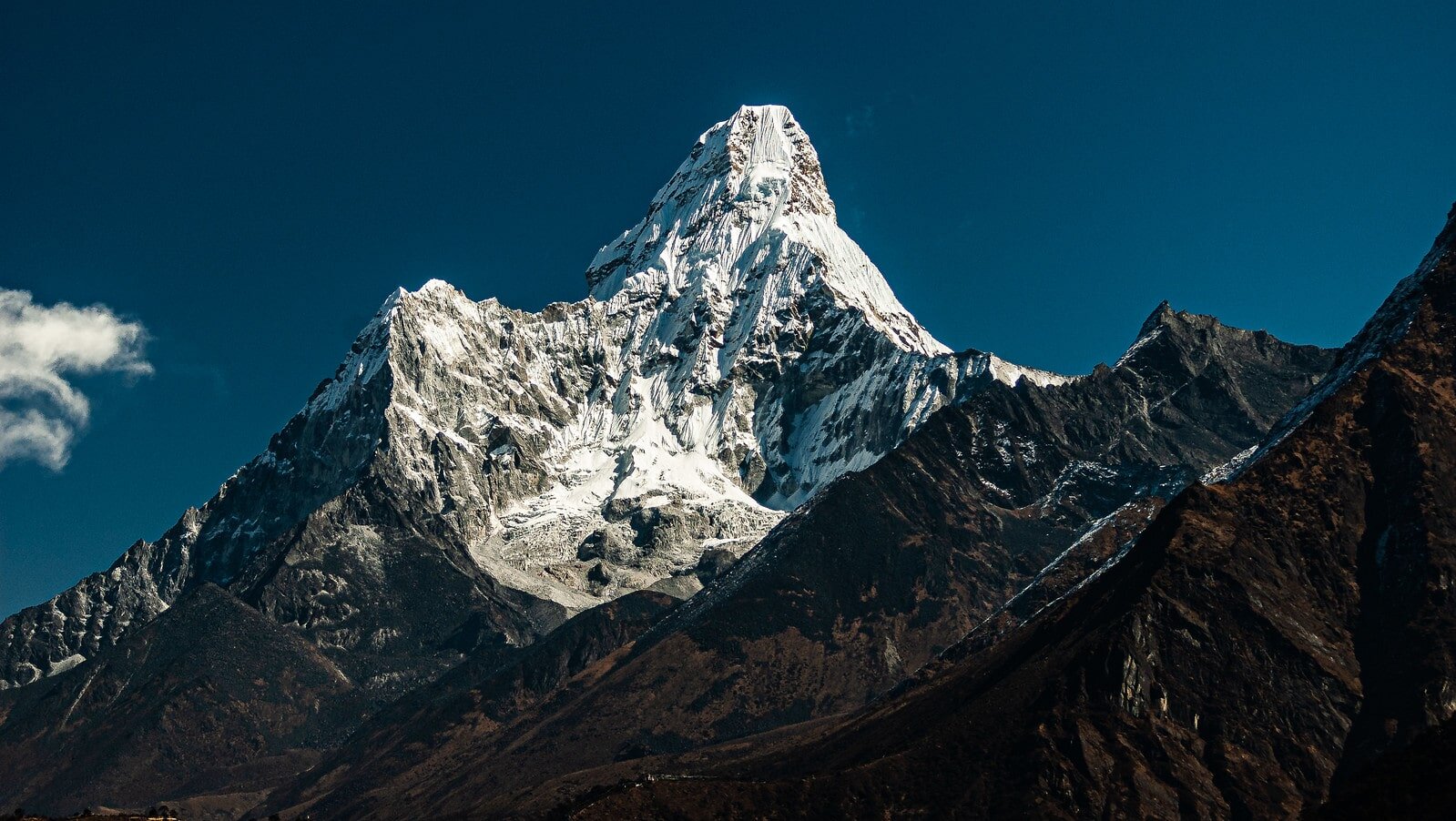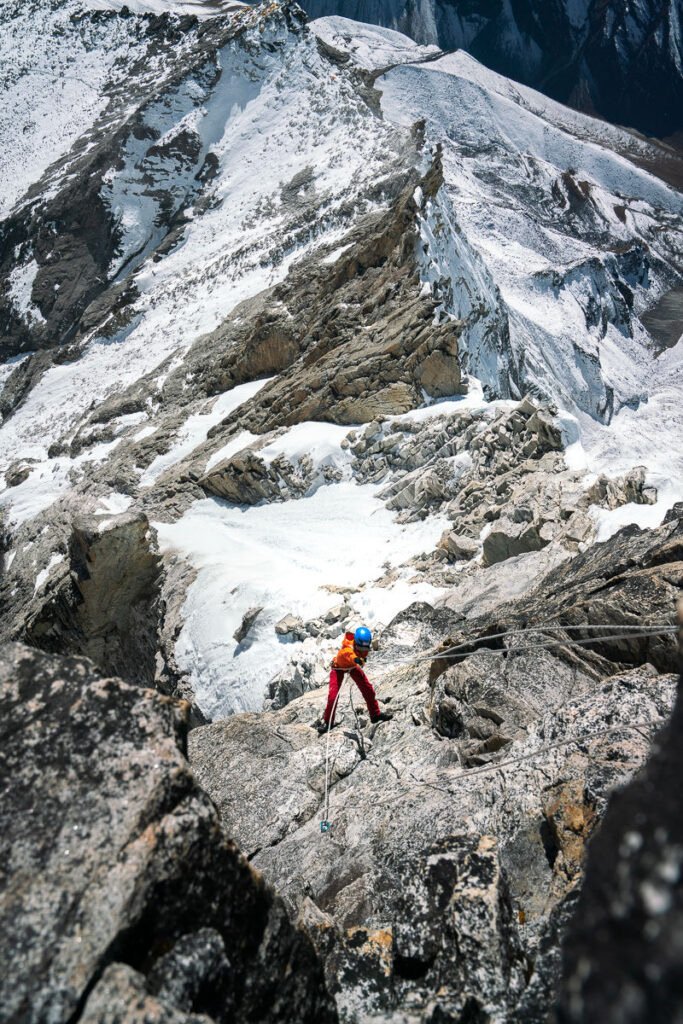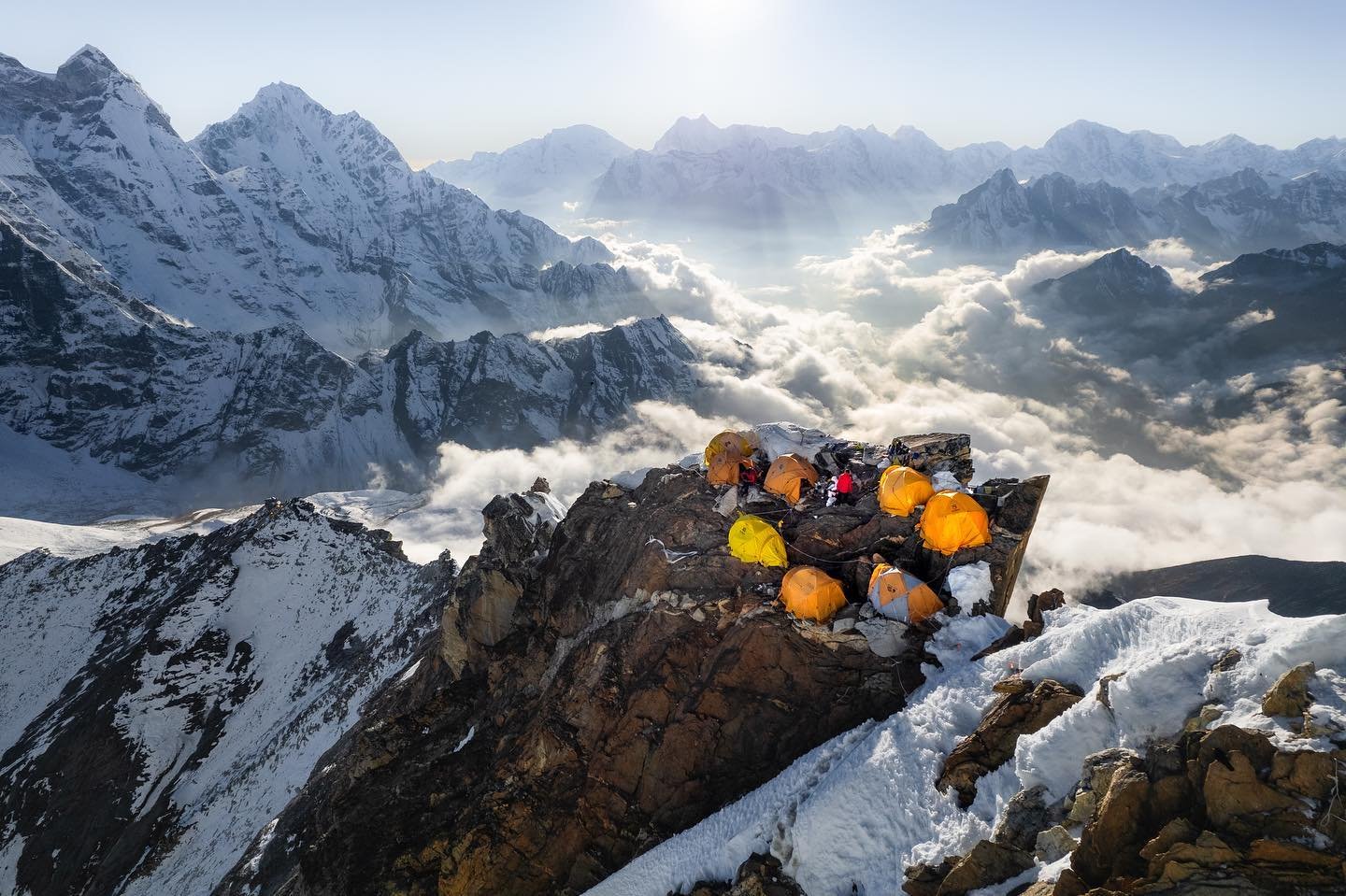10 important things to know about Ama Dablam climbing Expedition - Namas Adventure
Ama Dablam 6810M
Ama Dablam is known for its stunning beauty and is a highly sought-after mountain for mountaineering enthusiasts. It is considered a challenging climb on its own and is often viewed as a "must-do" for those who are interested in alpinism and mountaineering. Many people choose to tackle Ama Dablam either before or after attempting a larger expedition like climbing Mount Everest.
History: Ama Dablam was first summited on 13th March 1961, a Silver hut scientific expedition led by Sir Edmund Hillary. Ama Dablam's expedition has been a dream for many mountaineers. Its Southwest ridgeline is the safest route to climb this amazing peak.
We have listed 10 useful pieces of information that will help you prepare for your Ama Dablam peak climbing expedition.
1. When is the best time to climb Ama Dablam?
Ama Dablam is best suited to climb during three climbing seasons.
Spring (Mid-April-May) - There are hardly any climbers during the spring season solely because major expedition companies are focused on the Everest expedition. Climbers seeking fewer teams and climbers on the route are recommended to climb during spring.
and Autumn (September - November) - Autumn attracts a lot of climbers. You can expect a lot of teams climbing from Mid October - November end. November - December is less busy but a tad colder compared to peak October expedition.
Early Winter (December - January) - Winter climbs are for the extra gritty challenge seekers. This is another best time of the year when there are very few climbers and the Everest trails are quieter. Winter officially begins on 21st December. As expected be ready to brace for crispy cold and an unexpected gust of wind.
Note - Ama Dablam is the 3rd most sought technical climbing peak in the Khumbu region, with the majority of the permits being issued during the autumn season.
2. Climbing route and difficult sections, mountain grading of Ama Dablam climbing
All major commercial expeditions use the Southwest Ridge section route of the mountain. Ama Dablam expedition is graded at TD / 5 in difficulty. (Alpine / Fitness grading link).
Exposed section after Camp 2.
This expedition involves steep vertical mixed climbing on rock, ice, and snow. You must be in excellent physical and mental condition to tackle this challenging climb. Do not underestimate the difficulty of this mountain. Your previous climbing experience will help you gauge your fitness level and understand how to safely tackle the climb. With proper preparation and guidance from our team, you can achieve your dream of climbing Ama Dablam. The sheer vertical ascent of this mountain will likely be one of the toughest climbs you have ever attempted. However, the breathtaking beauty and exhilarating experience of reaching the summit make it all worth it. Are you ready to push yourself physically and mentally to reach the summit of Ama Dablam? It will surely be one of the most memorable peaks you ever climb."
Notable technical Sections at Ama Dablam climb.
Note - Your entire climb from camp 1 to the summit will be assisted by a fixed rope.
Climbing to Camp 2 “Yellow Tower”
Images by Jackson Groves / Journey Era
The route from Camp 1 to Camp 2 is one of the most technically challenging parts of the expedition. The climb to the top of Yellow tower involves a 90-degree vertical ascent. This section of the route is graded anywhere from 4.11 to 5.7 - 5.10 in rock climbing terms. It's important to consider the impact of altitude, carrying a backpack, cold weather, and ice conditions on the mountain while attempting this climb.
Mushroom Ridge 6250M (Between Camp 2 and Camp 3)
This section of the route is not for the faint-hearted, as you will need to carefully climb up and scramble on the steep rocky face of the mountain before reaching an exposed knife-edge ridge. Walk carefully across the ridge, which has 600-meter drops on both sides, before continuing your climb towards Camp 3.
3. How much does Ama Dablam expedition cost and what does it include?
The cost of the Ama Dablam and Island Peak expedition with Namas Adventure (Please click here for cost). Our team provides premium, all-inclusive services, including 1:1 climbing support, local guides who share their knowledge of culture and traditions, and a focus on safety, successful summit strategy, and top-quality base camp support. Our team is dedicated to being a responsible, ethical, and sustainable mountain adventure operator, so climbers can fully enjoy their climbing experience.
List of what’s included in your booking.
IFMGA/NMA certified Guide leader
Namas Branded merchandise (Down Jacket, Cap, Buff)
1:1 Sherpa Guide /client ratio.
Head chef and assistants ( Helpers increase with the number in climbing team members )
Arrival hotel in Kathmandu
All trekking and climbing permits (Khumbu Region Permit and TIMS)
All internal-local transportation to and from the trekking trailhead
Expedition tents (2 or 1 person tents) Brands Salewa, Mountain Hardwear, Samaya equipment, Kailas
30 kgs personal weight
Chocolate, energy bars, hydration pills, biscuits, canned foods, nuts
Burners and expedition equipment
Walkie-talkie/ Satellite phone/GPS
Breakfast, Lunch, and Dinner on trek and expedition days.
Lodge accommodation during the trek
Porters per guest
The arrival pick up and departure
Basic First aid kit
Welcome/Farewell leave Dinner
4. Are guides necessary for Ama Dablam Peak?
Climbing Ama Dablam requires a permit, which can only be obtained through a registered local company in Nepal. It is mandatory by Nepalese law to have a guide on high altitude peaks above 6,000 meters. We recommend hiring a guide for climbers of all levels, as a successful expedition requires a strong team with a proficient base camp crew and experienced, competent, and trustworthy climbing Sherpa guides.
5. Choosing the best-acclimated itinerary for climbing Ama Dablam
Proper acclimatization is crucial for success on any high-altitude climbing expedition. Our team follows the "climb high, sleep low" mantra and will conduct rotations to Camp 1 and 2 as part of our acclimatization strategy. Through our years of experience, we have carefully crafted the itinerary to ensure the best possible chance of success for your expedition.
6. How difficult is it to climb Ama Dablam? What training and skills are required?
Ama Dablam, also known as the "mountaineer's mountain," is a challenging climb that requires experience and determination to reach the summit. The route from the base camp to Camp 1 (5800 meters) involves climbing moraines and a rocky boulder uphill. The fixed line normally starts after Camp 1, where the climb becomes more technical. The climb to Camp 2, located on top of the Yellow Tower, is the first crux of the climb, requiring a 60-70 foot vertical granite ascent at 20,000 feet. The mushroom ridge from Camp 2 to Camp 3 is another challenge, and Camp 3 is only set up once the guide leader determines it is safe. From Camp 3, climbers head up the pyramid to the summit, which involves an exposed climb on 55-65 degree slopes. The descent is difficult, especially on tired legs, and requires careful focus.
Training for Ama Dablam
To prepare for this challenging climb, it is important to focus on endurance, core, and strength training. This will help you to handle the vertical sections of the ascent, such as the "Yellow Tower" on the way to Camp 2. Suggested training activities include long-distance running, cycling, and hiking with added weight. It is recommended to begin training at least 12 weeks in advance of your climbing departure. More on our training mountain expedition blog.
Skills
Additionally, taking advanced mountaineering classes can be helpful in learning technical skills like rope climbing and proper use of gear. For the Ama Dablam climb, it is recommended to be comfortable with multi-pitch climbs up to a grade of 5.10 a,b,c and to have experience with mixed climbing. Ice climbing skills up to WI-3 or WI-4 are recommended for spring climbs, although fixed-line ropes will be used for the steeper sections of the mountain.
You should be proficient with the above-mentioned mountaineering skills, climbing with ice axe support and abseiling independently in exposed mountain terrain. Be ready for a long descent when coming down from the summit. This is particularly where most of the incidents occur during this expedition. A few accidents did occur on this route when the climber did not properly attach the safety rope to the main fixed line when abseiling down the mountain.
Ama Dablam's climbing should not be taken lightly. By no means is the peak an easy climb and we require interested climbers to have a previous high altitude of several 4000M+ to 6000M+ technical climbing experience anywhere in the world. You have to be in your best physical fitness shape. All mountain expeditions are graded based on their technical and physical difficulties. Successfully accomplishing the Ama Dablam expedition is a mixture of teams, skills, the right experiences, fitness, mental strength, weather, and other detailed mountain-climbing factors.
7. Right clothing, gear, and boots (trekking and mountaineering)? Rental options for Ama Dablam climbing?
Choosing the right gear is very important. We advise climbers not to make compromises on the quality of gear and clothing, and to pay attention to layer up comfortably as well. You will depend highly on your clothes to keep you warm enough for the dropping temperatures at nighttime which can go down to -10c /-20c. Please check our equipment blog for recommended clothing and gear.
Renting your gear in Nepal? The simple answer is NO. This is one of the most frequently asked questions mainly by beginner climbers. We have tested and tried several gears in Nepal and frankly, we do not recommend hiring here. We know it might seem like a huge amount of expense to buy all the gear, but they are well worth it. You can even hire from the city you live in. Make sure they are original products from well-known adventure gear companies. (North face, Mountain hardware, Kailas, etc.)
Boots (trekking and mountaineering) for Ama Dablam climb
With better technologies, climbing shoes have improved every year. We highly recommend double-layered boots like Kailas Everest 8000M, La Sportiva Olympus Mons Cube, Scarpa 8000 phantom, and Millet Everest summit GTX. It is wise to spend on good mountaineering boots, as so with all the gears that we have mentioned in this post above.
More 8000M boots link here (other media article)
8. Hydration and nutrition
To ensure proper hydration, we recommend that all clients drink 4-6 liters of water per day. It is helpful to bring hydration tablets or filtration bottles. Obtaining water at higher camps can be difficult, so our team will do their best to boil snow and provide water at higher camps and during the summit push. Most meals are prepared in tea houses, and during climbing days, our Sherpa team sets up kitchen tents. While it can be difficult to eat enough in cold, high altitudes, it is important to try to force yourself to eat. We also provide packed dried meals as an alternative option.
It is important to avoid smoking and alcohol consumption during the Ama Dablam expedition. While it may be common to see the guiding leaders engage in these activities, they are professionals who have adapted well to high altitude environments. As a climber on this adventure holiday, it is important to prioritize your health and well-being by abstaining from these harmful habits. Remember to also pay attention to your diet and hydration, as these will greatly affect your performance on the mountain.
9. Insurance and Helicopter evacuation for Ama Dablam Expedition
No matter how prepared you are, you never know when or how things might go wrong. You might be sick suddenly or not that we wish but there might be some incident, you might suffer from altitude sickness or anything we can’t imagine yet. So, for these reasons, it is always good to have insurance coverage. Our recommended Insurance companies (link)
Helicopter evacuation is our final emergency option and we do recommend you have one in your insurance, as it is the only means of transport in the Everest region. Our guides will assess your condition and examine if it is a major issue. If not, they will use their experience to motivate and push you through your trip. However, in case of emergency, helicopter evacuation will be called upon.
There is a procedure to follow when calling for emergency evacuation. We will call the insurance company hotline, get approval from your insurance, and only then helicopters are sent to the distress call location. You will have to pay for the evacuation in Nepal from your own pocket but once you are back home you can claim your money back. Make sure you collect helicopter evacuation receipts, a certified doctor’s approval letter. The insurance company will ask for this evidence to back up your claim. There was a huge helicopter scam in Nepal in 2018, so insurance companies are taking extra measures to stop this from happening. Our guides and staff members in Kathmandu will also remind you of this process during briefings.
10. Next climbing goals after Ama Dablam climbing
It is only natural that as a climber, you would want to climb higher, more challenging peaks. Once you have successfully completed Ama Dablam, consider yourself one of the capable mountaineers. Climbers know that summiting Ama Dablam is no easy feat, so you should be able to take on even higher peaks, such as those over 8,000 meters, after this climb.
Mt. Everest Expedition 8848M
Manaslu Expedition
Annapurna IV 7525M
k2 8611m Expedition
A successful Ama Dablam climbs with a strong yet fun environment expedition team, proper training, and planning before the expedition is possible. These are the things that are within your control. As we have stressed enough Ama Dablam climb is not an easy one and you will have to get every aspect right so that you have a better chance of completing your expeditions and have a great time. Join our fun-loving yet providing the best service and safety team on our yearly Ama Dablam Expedition. Our team would love to have you on board and make your dream of climbing Ama Dablam a success.
Ama Dablam Expedition - Click here
If you do have any more questions, please ask us below in the comment section or you can email us at bookings@namasadventure.com and our team will get back to you as soon as they can. Stay well.
Challenge yourself. Dare great things and live your story.












